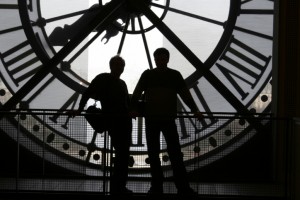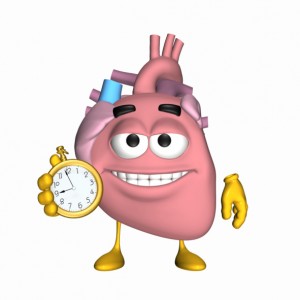The Time of Renewal and the Renewal of Time (Part 2)
By Asher Crispe: September 22, 2012: Category Decoding the Tradition, Inspirations
 One of the many teachings in the Kabbalah that pries open essential structures of the human condition, begins by tackling a veiled grammatical illusion in the word ‘Adam.’ The Zohar points out that this word can be seen as the letter alef added to the word dam which means blood. If we treat this alef as a prefix to a verb (nouns and verbs are converted into one another all the time in Hebrew) then it forms the first person of the future tense. When recombined with the rest of the word, it could be translated as ‘I will be blood.’ Why is Adam as the apex of all Creation structurally about becoming blood? Why is this connected to our sense of time on Rosh Hashanah?
One of the many teachings in the Kabbalah that pries open essential structures of the human condition, begins by tackling a veiled grammatical illusion in the word ‘Adam.’ The Zohar points out that this word can be seen as the letter alef added to the word dam which means blood. If we treat this alef as a prefix to a verb (nouns and verbs are converted into one another all the time in Hebrew) then it forms the first person of the future tense. When recombined with the rest of the word, it could be translated as ‘I will be blood.’ Why is Adam as the apex of all Creation structurally about becoming blood? Why is this connected to our sense of time on Rosh Hashanah?
To address this, let us first consider what blood might symbolize. The sages give us a hint when they tells us that ‘the blood is the soul (nefesh).’ According to Jewish tradition, there are five levels to the soul of which only three are enclothed within the body. The lowest of these is called the nefesh and it represents the vital soul which directly enlivens the physical body. Our flesh becomes permeated with life just as this vital fluid circulates within us. The notion that ‘I will be blood’ can be read ‘I’ (my essential self) is in a process of becoming, wherein my ‘I’ is continuously flowing and being recycled. Psycho-dynamically, we might refer to this as the transmutation of my essential self into a distributed self. I am producing from my ‘I’ a future state where my ‘I’ flows throughout my embodied self.
In the writings of the Mittler Rebbe, this name/identity for humanity is further unpacked. Continuing the meditation started in the Zohar, the Mittler Rebbe adds emphasis to the fact that the letters dam (blood) are spelled with a dalet and a mem. The encrypted significance for him is that dalet is the initial letter for the word dibur which means ‘speech,’ while mem is the first letter of the word ma’aseh meaning ‘action.’ Their aggregate meaning would be something akin to ‘communicative action’ or ‘speech-acts.’ Both speech and action are expressions of self to the outside. External reality receives that which is transmitted from the disseminated ‘I’. The ‘currency’ of self has to do with the promulgation of these forces which all stem from the alef which in turn converts one’s inner being into becoming.
However, the alef itself can refer to the inner garment of the soul known as thought (machshavah). My thoughts, relative to my speech-acts, remain exceedingly close to me, clinging to my core and bound in silence as far as the outside world is concerned. Housed in the warehouse of my mind, they remain one with me. This oneness or unity is embedded in the letter alef [א] in that it equals 1 in gematria. Furthermore, pictographically the alef sustains a contradictory state in that it may be further broken down into a letter yud [י] on the top right hand corner and a yud [י] below in the lower left hand corner which are both connected via a diagonal vav [ו]. The kabbalists inform us that this is emblematic of paradox, a tension between our higher nondescript unembodied self and our lower measurable physical manifestations. Thought embraces both the abstract and the concrete. It spans the inner higher worlds and the outer lower worlds. Thus, the head or figure of thought must be transformed into embodied expressions of self via the mechanisms of communicative action.
Kabbalah enjoins us to anthropomorphize time frames. They take on human form and in doing so become more relatable. We have already demonstrated the humanizing of time by giving the new year a head (rosh). Logically then, if there is a head then it must be attached to a body. This is precisely the interpretive move that the esoteric tradition suggests. The rest of the year in relation to Rosh Hashanah would be the temporal ‘body.’ So just as all of the parts of the body express the thoughts and desires of the head (where the head implies leadership as well), so too all the months and weeks and days of the year are the speech-acts of the ‘head’ of the year.
Each day has its own cluster of nerves, its own pathways of veins and arteries which transfer and execute the commands of the head. The ‘head’ of consciousness of the ‘body’ of time as change (year means change: shanah/shenui) exports my temporal core (which functions like an accordion collapsing the year in on itself so that I am availed of the opportunity to think about it) as a distributed embodiment of time. Telescoping the days of the year back out to their full measure of duration (unlike the time dilation that compressed time into a 48 window) affords us the capacity to organize time on a theoretical level before it is actualized through communicative-action.
The body of time on Rosh Hashanah might be compared to the ‘body without organs’ to use a Deleuzian expression. The ‘body without organs’ is a dedifferentiated body that is experienced as a ‘plain of consistency’ or as an undivided whole that remains unconscious of its parts. If the days of our lives were not included in a set that is named a year, they would be like organs without a body. It follows that each differentiated time unit is likened in Kabbalah and Chassidut to a different limb or organ of the body of time. The organs organically organize time. Every organ has its position and relationship as compared with other organs. Moreover, each organ has a particular function. Wasting a day would then be tantamount to organ necrosis. Excessive damage to an organ of time may be healed through organ transplant however. If I did not accomplish something that I set out to do on a given day, there might be the opportunity on another day. A Monday can function like a Friday once in a while. It depends if another suitable organ of time is available. They often run in short supply. Consequently, organ transplant within the temporal body may prove to be a strange form of time travel.
Finally, when we are in the abstract planning stages of anything, when our future activities are being dramatized in our mind’s eye and imagination, it can happen in the blink of an eye. Want to clean the house? As I think about it it seems so easy. My mind can move quickly from room to room straightening up the mess. But, as everyone knows, when we actual go to clean it takes time. Much more time than we would have thought. This is because thought (as in the head of the year or the time of change) can dilate time at will. The blood can only circulate through the organs of the body of time so fast. Bringing ideas into the realm of speech and action slows them down.
 Recently, my wife and I involved a friend in the installation of a new oven. When we thought about it, it was only a few seconds and boom: a new oven complete with hookup in a custom cabinet appeared before our very eyes in the place of the old one. When we sat down to describe to our friend what we had thought about, we suddenly found that it required a lot of back and forth discussion to communicate the logistics of the entire process. We spent way more time speaking about it than we had thinking about it. In the end, we were astonished that the job took weeks to finish. Action is far slower than words. It takes time. Real time. Each and every cut, the scheduling of the electrician, the staining of the cabinets and the clean up, were expansive. The thinking-time (the thinking of time) which is also the time of thinking generates ideas in the head of time that can swell beyond our wildest expectation, precisely because we confused the head with the body of time.
Recently, my wife and I involved a friend in the installation of a new oven. When we thought about it, it was only a few seconds and boom: a new oven complete with hookup in a custom cabinet appeared before our very eyes in the place of the old one. When we sat down to describe to our friend what we had thought about, we suddenly found that it required a lot of back and forth discussion to communicate the logistics of the entire process. We spent way more time speaking about it than we had thinking about it. In the end, we were astonished that the job took weeks to finish. Action is far slower than words. It takes time. Real time. Each and every cut, the scheduling of the electrician, the staining of the cabinets and the clean up, were expansive. The thinking-time (the thinking of time) which is also the time of thinking generates ideas in the head of time that can swell beyond our wildest expectation, precisely because we confused the head with the body of time.
Hopefully, armed with a new sense of time, our timing in the future will be better. Thinking up a whole new year, to organize our future time requires tremendous powers of concentration. Remembering to account for the time compression in the process will make for a more timely and fulfilling change.
In Part Three, our attentions turns to the granularity of self.














;)
;)
;)
;)
;)
;)
;)
;)
;)
;)
